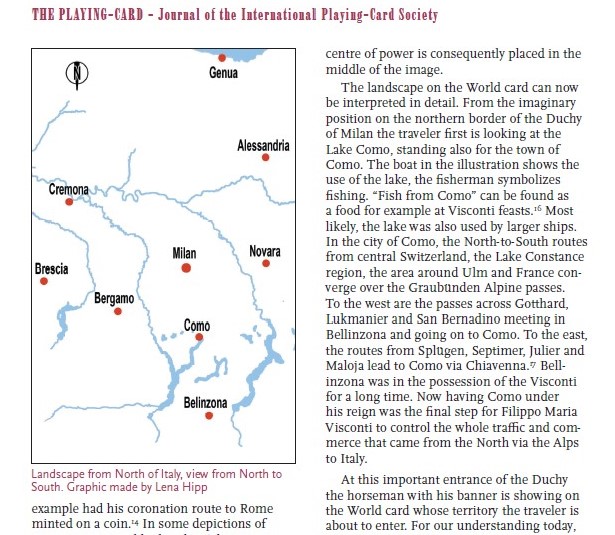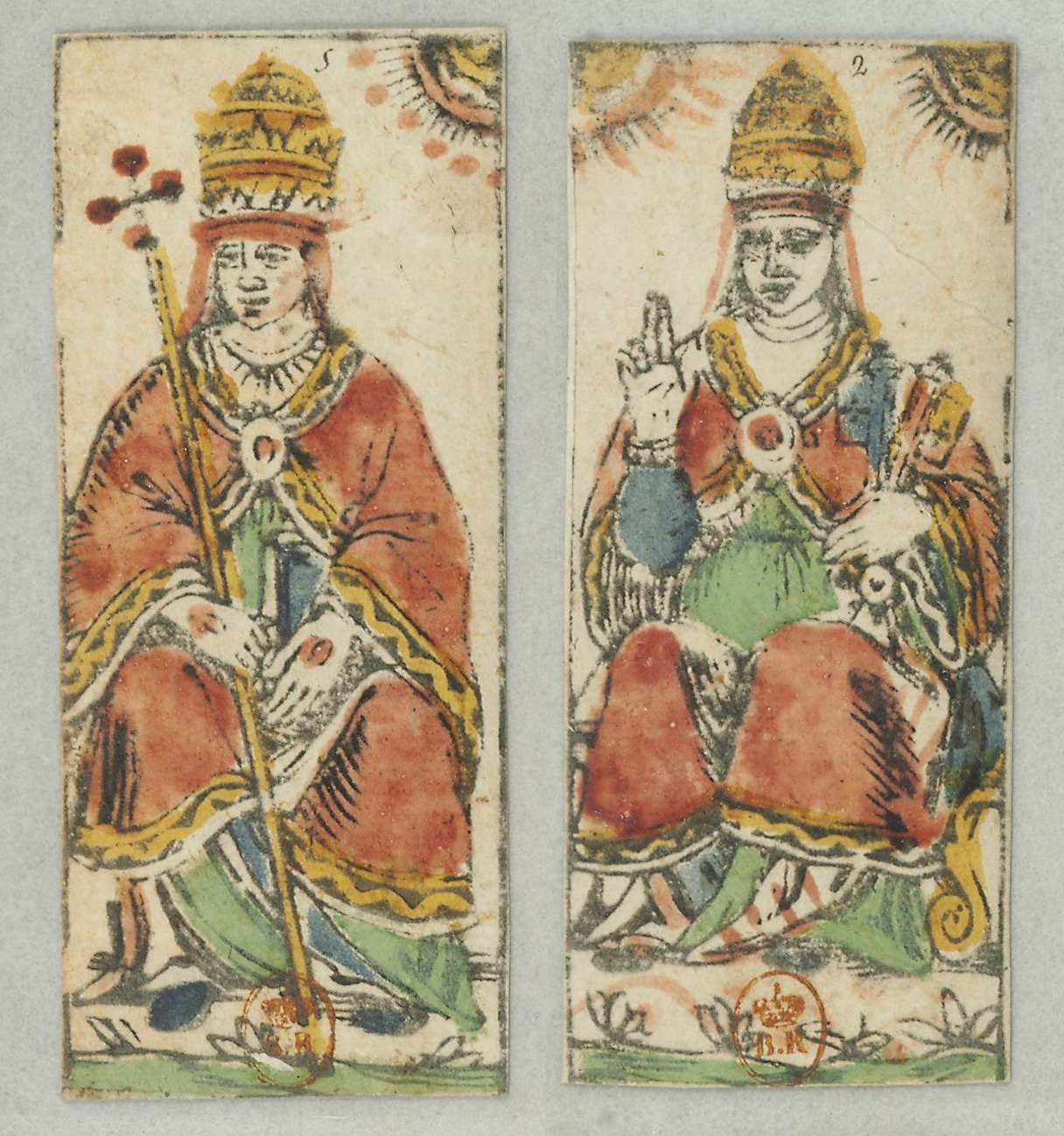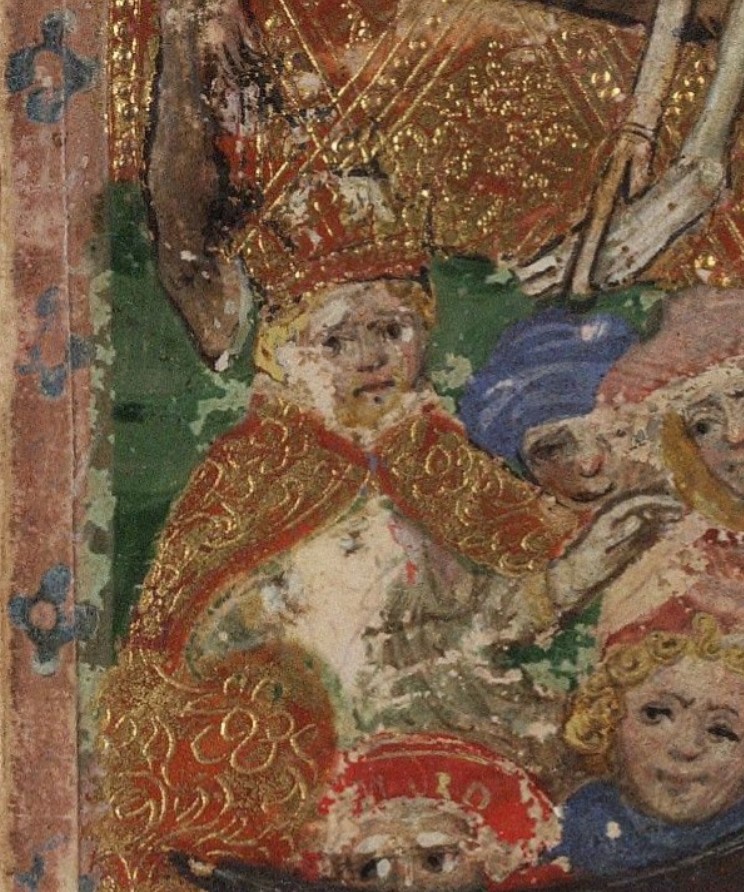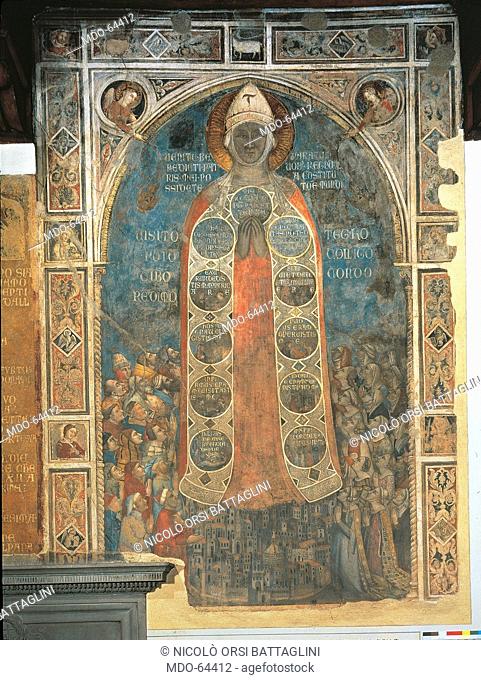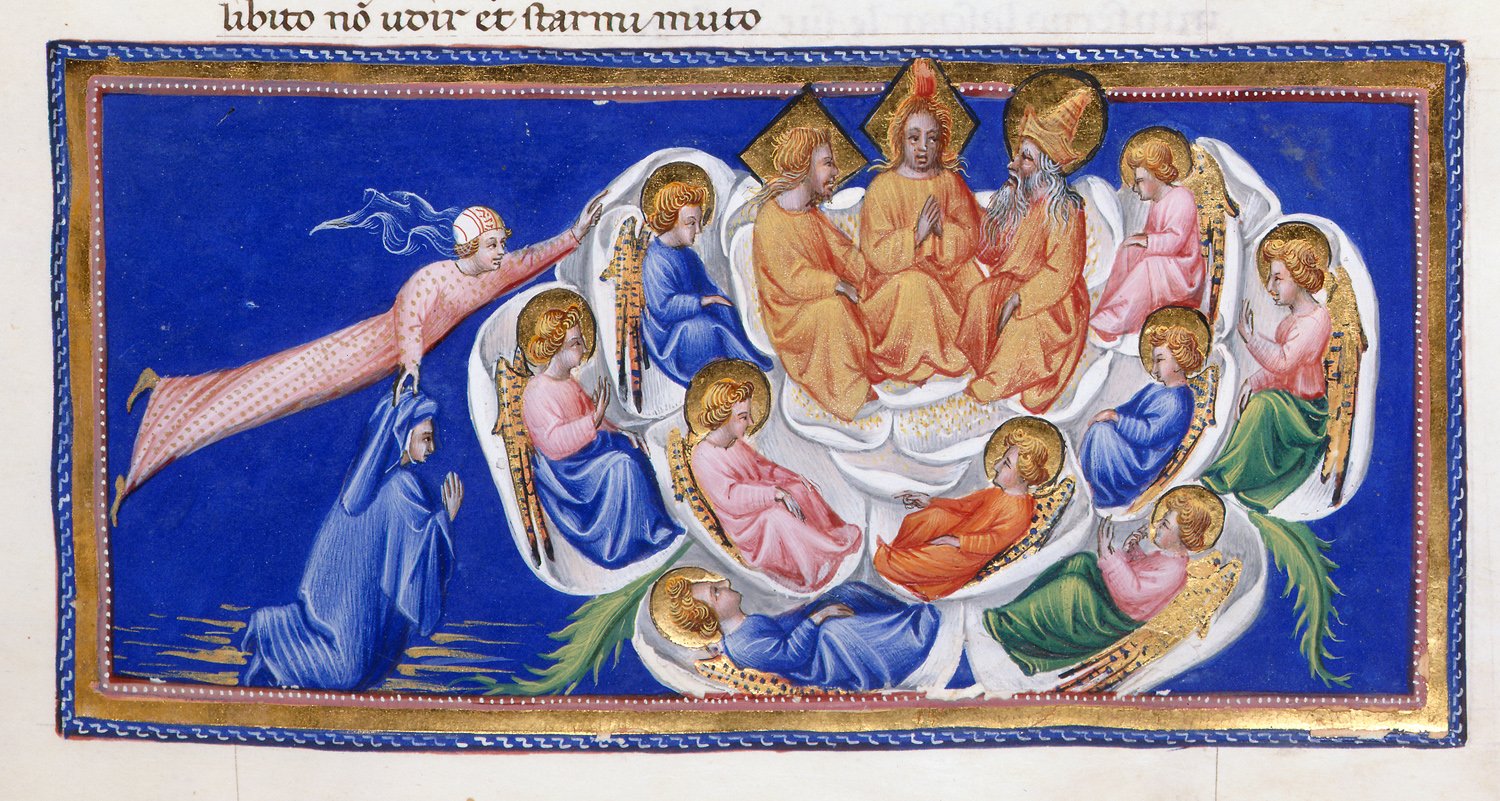I want to add a few things to the preceding post. I wrote:
The question remains, however, whether there could have also been a simple formula if the cards were numbered differently. In that case, the numbers might have come first, then the formula. I don't think so, but it has to be thought through. My guess is that the rules would have to change, too. In particular, it is a formula for calculating points, not cards, and requires that the first three cards have 10 points total, then 5 points for each additional cards, and that both the Bagattino and the Matto be wild cards. That the rules were constructed in order for the formula to work seems the wrong way around: it is just too strange.
Actually, from what is presented on pagat.com, the numbers might well have come first, even with all the rules the same. All that is needed is a slight change in the formula.
Before quoting pagat.com, I need to say what contatori are: they are what I have called wild cards, namely the Bagattino and the Matto. They can substitute for single-card gaps in the sequence, once it is established, and go at the end if not used. They count as the cards they substitute would, namely, 5 points. Also, I need to explain why the formula is used even in cases where it is just as easy to count the points. The custom in Bologna is that at the end of the round only one side shows the cards they have amassed in tricks; from them the short-cut can be used to show one side's points from the other side's cards. Now here is Pagat.com :
1. If the opponents of the Angel have the World, Sun and Moon, or if they have two of these three cards with both contatori, there is no grande [grande is the name of a sequence that starts with the Angel].
2. Otherwise, identify the scavezzo (breaking card) - the highest numbered trump held by the opponents of the Angel that is not in the grande. Count how many contatori and trumps higher than the scavezzo the opponents of the Angel have, add this to the number of the scavezzo itself, subtract the result from 21 and multiply by 5. This is the value of the grande.
3. If there is no scavezzo - so that the team with the Angel have a grande fino ai calzettini (down to the socks) - then the scavezzo number is zero. Count all the trumps and contatori held by the opponents of the Angel, subtract that number from 21 and multiply by 5.
Then pagat.com gives examples, first from the perspective of the sequence itself:
1. Angel, World, Moon, 16: trump sequence of 4, worth 15 points
2. Angel, Matto (for the World or Sun), Moon, 16, 15, Bégato (for the 14), 13, 12: trump sequence of 8, worth 35 points. Note it is not necessary to replace both the World and the Sun with wild cards.
3. Angel, World, Sun, Moon, 16, Matto, Bégato, 13: trump sequence of 7, worth 30 points. Note this is not a sequence of 8: both the 15 and the 14 are missing, the gap of two stops the sequence, and the 13 cannot be added.
And then from the perspective of the scavezzo:
In example 1 above the scavezzo is the 15, and the opponents of the Angel have both contatori and the Sun. 15+3=18. 21-18=3. The value of the grande is 3×5=15.
In example 2 the scavezzo is the 11, and the opponents of the Angel have the World, Sun and 14 of trumps. 11+3=14. 21-14=7. The value of the grande is 7×5=35.
In example 3 the scavezzo is the 15 and the opponents have no trumps or contatori to count. 21-15=6. The value of the grande is 6×5=30.
If the opponents of the Angel have nothing relevant except the 7 of trumps, the Matto and one Moor the scavezzo is 0, 21-3=18 and the value of the grande is 18×5=90. This is a case in which the scavezzo method is clearly quicker than counting all the cards in the grande. The team with the grande will also score 15 for their sequence of Moors in this case.
Now here is what I want to say about that formula:
If Love was 6 and not 5, the formula could have just added one to the number to be subtracted from, i.e. 22 and not 21. Since there are 20 regular trumps and 2 contatori, 22 is perfectly reasonable. In that case, whatever Mori the opponents of the team with the Angel have will count as breaking the sequence. The number will be 5 (one less than that of Love) if they have all four, 4 if they have three, 3 if they have 2, 2 if they have 1. If none, you subtract 1 from 22. It is only this last that is counter-intuitive. But it is just a formula.
In pagat.com's first example, the scavezzo is the 15. The opponents of the team with the Angel have both contatori and the Sun. 15+3=18. 21-18=3. 3x5=15 points.
But subtracting from 22, if the scavezzo was 16, the result would be the same. 16+3=19. 22-19=3. 3x5=15.
Then if Love breaks the sequence, and the opponents have both contatori, we would have 6+2=8. 22-8=14. 14x5=70. This is the same as subtracting 5 from 21: 5+2=7. 21-7=14. 14x5=70.
In the case where the grande goes down to the Mori, it is whatever Moro breaks the sequence that is the scavezzo. Let us assume that the opponents of the Angel have 3 Mori and no contatori. Without contatori, they will have whatever two trumps the possessors of the Angel used the contatori to substitute for them. By the conventional formula, you add 3+2=5, subtracted from 21 equals 16. So the sequence totals 80. By the new formula, it is the second Moro, numbered 4, that breaks the sequence, which in the alternative will have the number 4+2=6, and 22-6 = 16. Either way, 16x5=80 points.
It is true that this business of adding one to the number of Mori is a bother. But it is easily gotten used to.
However, Pisarri's text refutes this argument. It is not that he has the numbers in his text (p. 40, bottom, shown in the last post) even before there were numbers on the cards. We don't actually know when numbers were put on the cards. If it was a gradual operation, Pisarri could have been conforming himself to a deck that did have numbers. It is true that he says he is copying an old manuscript, but in this part he may not be. Alternatively, the cards may have been commonly referred to by scavezzo number even before numbers were on the cards.
What is more important is Pisarri's way of thinking about the formula, which gives its rationale rather than just presenting a formula. He says (p. 41):
Spiegato ora il numero distinto d'ogni Trionfo, discendo a mostrar con due esempi la maniera d'adoperare gli stessi numeri. Pongasi dunque che quelli, che hanno perduto, si trovino avere in Tavola Amore e Vecchio e Matto. In questo caso sarà d'uopo notare l'ultimo Trionfo, che cavezza, e ricordandosi il numero, ch' egli ha, far così: all'Amore, che ha il 5, aggiugnere 'A Vecchio, e dire 6 poi il Matto, e dire 7. Fatto questo, si dovrà multiplicare eso numero 7 per 5 che fa 35, i quali 35 punti cavati dalli 105 punti di tutta la sequenza delIa Granda, restano 70 punti, numero preciso, che si ricavava dalla detta sequenza.
Having now explained the distinct number for each Triumph, I proceed to show with two examples the manner of using these numbers. Let it therefore be assumed that those who have lost are found to have Love and Old Man and Fool on the Table. In this case, it will be necessary to note the last Trump, which makes the break, and remembering the number it has, do as follows: to Love, which has 5, add to it the Vecchio, and say 6, then the Fool, and say 7. Having done this, you will have to multiply this number 7 by 5 which makes 35, which 35 points taken from the 105 points of the whole sequence of the Granda, there remain 70 points, the precise number obtained from said sequence.
This is the same procedure as on pagat.com, but presented differently. You start with the number of the card that makes the break, then add to it however many trumps are above it that the other team has (in this case the Vecchio, Old Man), plus whatever contatores it has (in this case the Fool). Then instead of subtracting it from 21 and then multiplying by 5, he multiplies by 5 and subtracts from 105 (21x5), which yields the number of points in the sequence.
Pisarri's second example (see my previous post) is a little more complex. The opponents of the team with the Angel have the Sun, the Tower, the Hanged Man and the Wheel. This means that the team with the Angel has Angel, World, and Moon, starting the sequence without the need for any wild cards, as well as the Star, to continue it. Then between Star and Devil it substitutes the Matto or Bagattino for the Tower. It then continues with Devil and Death with a gap of one after the latter. It uses the second wild card to substitute for the Hanged Man, between Death and Old Man. Lacking the Wheel, it has run out of wild cards and the run has to stop. To calculate the value of the sequence, you take the number of the Wheel, 10, and add the number of trumps above it not used in the sequence, 3 (not their scavezzo numbers, just how many cards there are), for 13. 13x5=65. 105-65=40, the value of the sequence.
For Pisarri - employing a common practice in tarocchi games - what is important is the total number of points and subtracting from that. Since it is 105, that prevents the version that subtracts from 22, because 22x5=110, not 105. That is, you subtract the points prevented by the break from the total possible. That number is given by the scavezzo number of the card causing the break, in the possession of the team that didn't have the Angel, plus whatever other trumps above it (including the Matto and the Bagattino) it has. From this perspective, it is absurd to make the figure to be subtracted from 5 more than the actual maximum.
We could change the total number of points to 110 if the value of the first three cards of the sequence totaled 15 instead of 10. But in that case, paradoxically, the scavezzo doesn't change. So in example 1, where the sequence is Angel, World, Moon, Star. The four cards = 20 points. Oddly enough, the scavezzo is still 15. 15+3= 18. 18x5 = 90. 110-90 = 20. Total number of points for 22 cards = 110.
So let us try 115. 16+3=19x5=95. 115-95 = 20. The first three get 15 points, which is what we wanted. But now the total number of points is still 22x5=110. It's not 115.
I have no idea whether there is some combination of points for an initial number of cards plus some other number per card that can have 16 as its scavezzo number. I haven't found one. It seems to be 15 that works.
But it is still worth asking, why is it that the first three cards are worth 10 and not 15? In Minchiate , sequences of at least three of the top five cards, Angel to Star, are worth 10 points per card, however many of the five one has. If it had been 5 points per card, three cards would be worth 15 points, not 10 as in Tarocchino. My answer: The feature of increasing the number of points per card as the combination becomes more difficult is also seen in the scoring of the criccone (3 or 4 of a kind); there it is even worse: 4 cards are worth twice what 3 cards are worth, and is doubled again if a team has three or more criccone.
Another question: Could the Bolognese game of Ottocento, more or less, or at least its way of scoring sequences, have been the game played in Florence early on, so that the numbers on the cards of the Charles VI (ChVI) were scavezzi, and all that was different was a slightly different order of trumps (Fortitude, Chariot)? There is more of a difference than the order of trumps: there is no reason for scavezzo numbers on the cards below Love and on the top four, if the game was Ottocento. If it was a variant in which the "papi" were ranked by gender and papal vs. imperial, there still wouldn't be numbers on the top four. Those numbers on the ChVI have as their only function that of indicating their order. However, I suppose that could be someone's personal preference: if you're going to number the rest of the cards, why not the last few?
Then there is the question of the unnumbered Bagatello. In Minchiate, a Florentine game, the only card that could be added to sequences was the Matto. Is there any other reason why it would be unnumbered in the 78 card version that preceded it, having to do with the the scoring of points in sequences? What concerns me is whether it is necessary to have the Tower at 15, to serve as a scavezzo number, and so on all the way down. Then Love will have to be 5. If so, and there are four "papi," the Bagatello is left at 0. This requires more thought.
Corrected from what was here originally a few hours earlier.
One further thought, added a little later: On the other hand, if the team with the Angel wins all the trumps and the Matto, but doesn't get the Bagatello - assuming it is not a contatore - then it doesn't have all 105 points, so that the Bagatello can't have a scavezzo number of zero. It has to be 1, taking away 5 points from the 105. Yet Love is 5, and there are four "papi." I don't get it.
Added next day: Let me try again. With just one contatore, the maximum number of points is still 105. However there is one less contatore to add to the scavezza. In example one, where the granda is Angel, World, Moon, Star, if the scavezzo is 15, we add the Sun and the Matto, 15+2 = 17, 17x5=75. 105-75=30. But in fact the granda is 15. If the scavezzo number is 16, then the computation is 16+2= 18. 18x5=90. 105-90=15, which is correct. That was my mistake, assuming that the scavezzo number would be the same with one contatore. The Tower card has to be 16, the same as its ordinal number. In that case, on condition that the Matto is the only contatore, the little numbers on the Charles VI wouldn't be scavezzo numbers.
Now let me add my other variation, that the first three cards of the Grande have the same value as the rest of the cards, 5 points. In that case example one is a granda of 20 points, and the total number of points is 110. In that case 16 + 2 = 18. 18x5= 90. 110-90= 20. So that variation still doesn't make any difference.
Now my conclusion is that the numbers on the Charles VI, at least those below the Moon, are scavezzo numbers only if the game in Florence was the same as in Bologna, with both the Bagatella and the Matto as contatori. Well, I suppose that is not very remarkable. Minchiate could have reduced the contatori to one easily enough. Since a form of Minchiate already existed by the time the numbers were added, it would have been rather confusing for players, but not too badly, as other rules would have been different, too. The main problem is why the Bolognese would have waited so long to put scavezzo numbers on the cards. It seems likely that they discovered the short cut only later. Pedini does not mention it. Whoever put the numbers on the ChVI could have discovered it independently. There remains the issue of why the Moon, Sun, World, and Angel would have been numbered. It seems to me that it was only to indicate the order. If the rest of the numbers were scavezzi, such numbers would suggest that a grande was possible with even one or two of the highest cards, the third filled in by a conttore. If they are not scavezzi, probably the same would have been true throughout. In that case the Bagatello would have been number 1, not unnumbered, so as to distinguish it from the Matto, and the analogy to Bologna fails. How strong this argument is I'd better not say at this point, as there are also arguments on the other side.

